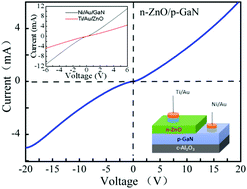当前位置:
X-MOL 学术
›
J. Mater. Chem. C
›
论文详情
Our official English website, www.x-mol.net, welcomes your
feedback! (Note: you will need to create a separate account there.)
Ultraviolet electroluminescence from a n-ZnO film/p-GaN heterojunction under both forward and reverse bias
Journal of Materials Chemistry C ( IF 5.7 ) Pub Date : 2018-10-08 00:00:00 , DOI: 10.1039/c8tc04507k Qiu Ai 1, 2, 3, 4, 5 , Kewei Liu 1, 2, 3, 4, 5 , Hongyu Ma 1, 2, 3, 4, 5 , Jialin Yang 1, 2, 3, 4, 5 , Xing Chen 1, 2, 3, 4, 5 , Binghui Li 1, 2, 3, 4, 5 , Dezhen Shen 1, 2, 3, 4, 5
Journal of Materials Chemistry C ( IF 5.7 ) Pub Date : 2018-10-08 00:00:00 , DOI: 10.1039/c8tc04507k Qiu Ai 1, 2, 3, 4, 5 , Kewei Liu 1, 2, 3, 4, 5 , Hongyu Ma 1, 2, 3, 4, 5 , Jialin Yang 1, 2, 3, 4, 5 , Xing Chen 1, 2, 3, 4, 5 , Binghui Li 1, 2, 3, 4, 5 , Dezhen Shen 1, 2, 3, 4, 5
Affiliation

|
ZnO film was fabricated on p-GaN film using the molecular beam epitaxy technique to form heterojunction light emitting diodes (LEDs). The devices exhibited strong light emission under both forward and reverse bias. The origin of different luminescence peaks has been investigated by comparing electroluminescence (EL) and photoluminescence spectra. When a forward bias is applied to the device, intense ultraviolet emission at ∼376 nm originating from ZnO rather than GaN can be observed, which is associated with the larger hole mobility of p-GaN than the electron mobility of n-ZnO. Under the reverse bias, the device shows broad emission at 520 nm originating from deep level-related recombination in ZnO, emission at 430 nm from GaN, 376 nm from ZnO and weak emission at 408 nm from the interface with a lower injection current of 10 mA. As the injection reverse current increases to 20 mA, the EL emission at 376 nm exhibits a dramatic increase in intensity without a peak shift. The emission mechanism of the heterojunction LED is discussed in terms of interface states and energy band theory. Our findings in this work provide an innovative path for the design and development of ZnO-based ultraviolet diodes.
中文翻译:

正向和反向偏压下n-ZnO膜/ p-GaN异质结的紫外电致发光
使用分子束外延技术在p-GaN膜上制备ZnO膜,以形成异质结发光二极管(LED)。该器件在正向和反向偏置下均显示出强光发射。通过比较电致发光(EL)和光致发光光谱,已经研究了不同发光峰的起源。当向器件施加正向偏压时,可以观察到在〜376 nm处发自ZnO而不是GaN的强烈紫外线发射,这与p-GaN的空穴迁移率比n-ZnO的电子迁移率大有关。在反向偏置下,该器件显示出520 nm处的宽发射,这是由于ZnO中与深能级相关的重组,GaN中430 nm处的发射,ZnO中376 nm处的发光以及来自界面的408 nm处的弱发射以及较低的注入电流10嘛。当注入反向电流增加到20 mA时,在376 nm处的EL发射显示出强度的急剧增加而没有峰移。根据界面态和能带理论讨论了异质结LED的发射机理。我们在这项工作中的发现为基于ZnO的紫外线二极管的设计和开发提供了一条创新的途径。
更新日期:2018-10-08
中文翻译:

正向和反向偏压下n-ZnO膜/ p-GaN异质结的紫外电致发光
使用分子束外延技术在p-GaN膜上制备ZnO膜,以形成异质结发光二极管(LED)。该器件在正向和反向偏置下均显示出强光发射。通过比较电致发光(EL)和光致发光光谱,已经研究了不同发光峰的起源。当向器件施加正向偏压时,可以观察到在〜376 nm处发自ZnO而不是GaN的强烈紫外线发射,这与p-GaN的空穴迁移率比n-ZnO的电子迁移率大有关。在反向偏置下,该器件显示出520 nm处的宽发射,这是由于ZnO中与深能级相关的重组,GaN中430 nm处的发射,ZnO中376 nm处的发光以及来自界面的408 nm处的弱发射以及较低的注入电流10嘛。当注入反向电流增加到20 mA时,在376 nm处的EL发射显示出强度的急剧增加而没有峰移。根据界面态和能带理论讨论了异质结LED的发射机理。我们在这项工作中的发现为基于ZnO的紫外线二极管的设计和开发提供了一条创新的途径。











































 京公网安备 11010802027423号
京公网安备 11010802027423号